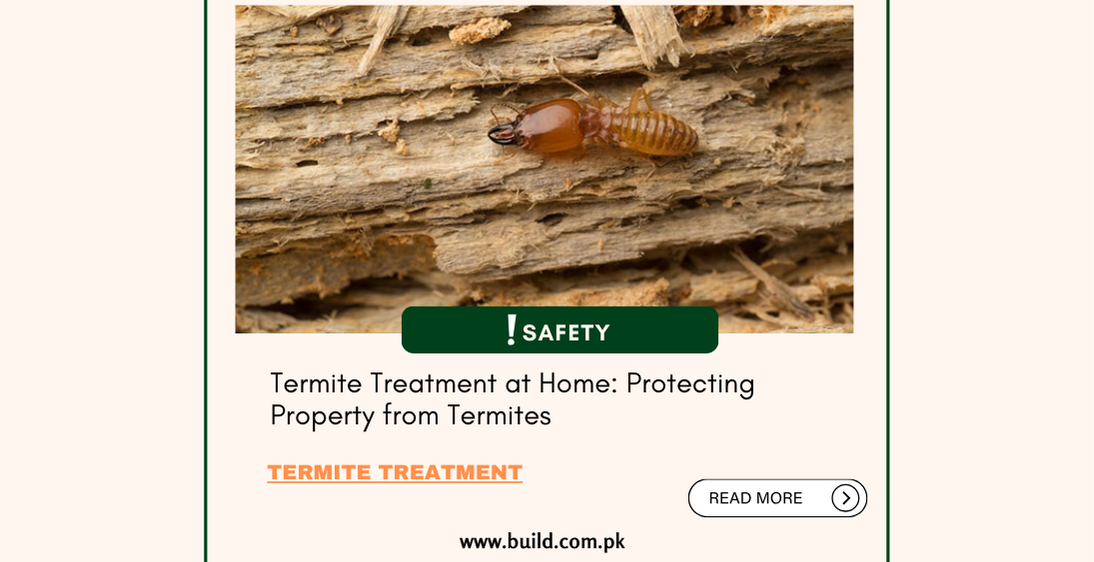Termite Treatment at Home: Protecting Property from Termites

Introduction:
Termites are silent invaders that can cause
significant damage to your home if left unchecked. Implementing effective
termite treatment at home is essential for protecting your property and
preserving its structural integrity. In this detailed guide, we'll explre
everything you need to know about termite treatment, including identification,
prevention measures, DIY treatments, professional options, and long-term
strategies to keep termites at bay.
Understanding Termites
Before diving into termite treatment
methods, let's gain a better understanding of these destructive pests:

Types of Termites
Subterranean Termites: These termites build their colonies
underground and access structures through mud tubes. They are the most common
type of termite found in homes.
Drywood Termites: Unlike subterranean termites, drywood
termites do not require soil contact and can infest dry wood structures, such
as furniture, doors, and framing.
Dampwood Termites: Dampwood termites thrive in moist
environments and are typically found in decaying wood, fallen trees, and damp
structural lumber.
Signs of Termite Infestation
Mud Tubes: Subterranean termites construct mud tubes along
walls, foundations, and other surfaces to travel between their colony and food
sources.
Swarming: Termite swarmers, or reproductive adults, emerge in
large numbers during matig season, often indicating the presence of a nearby
colony.
Wood Damage: Termite-infested wood may appear hollowed out, with
tunnels or galleries running along the grain.
Discarded Wings: After swarming, termites shed their wings,
leaving behind piles of discarded wings near windowsills, doors, or light
fixtures.
DIY Termite Treatment Methods
While professional assistance
may be necessary for severe infestations, there are several DIY termite
treatment options you can try at home:
Liquid Termiticides:
Liquid termiticides, such as those containing bifenthrin or imidacloprid, can be applied around the perimeter of your home to create a barrier against termites. Follow the manufacturer's instructions carefully and apply the termiticide to the soil around the foundation, paying particular attention to areas where termites are likely to enter.
Termite Bait Stations:
Termite bait stations are placed in the ground around your home and contain cellulose-based bait that attracts termites. Termites feed on the bait and carry it back to their colony, effectively eliminating the entire colony over time. Monitor the bait stations regularly and replace the bait as needed to maintain effectiveness.
Borate-Based Treatments:
Borate-based treatments, such as borax or boric acid, can be applied directly to infested wood or used as a preventive treatment on untreated wood. Borates disrupt the termite's digestive system and can effectively control infestations when applied correctly.
Professional Termite Treatment Options
For severe or
widespread termite infestations, professional treatment may be necessary.
Professional termite control options include:
Soil Treatment:
Professional pest control technicians can apply liquid termiticides to the soil around your home's perimeter, creating a chemical barrier to prevent termite entry. Soil treatments may also involve drilling into concrete slabs or foundation walls to apply termiticide directly to the soil beneath.
Fumigation:
Fumigation is a highly effective termite treatment method for severe infestations or inaccessible areas. During fumigation, the home is sealed and filled with a lethal gas, such as sulfuryl fluoride, which penetrates walls, furniture, and other structures to eliminate terites.
Termite Baiting Systems:
Professional pest control companies can install and monitor termite baiting systems around your home to eliminate termite colonies. Termite bait stations are strategically placed in the ground and contain a slow-acting toxicant that is ingested by termites and spread throughout the colony. Preventive Measures to Avoid Termite Infestation: In addition to treatment options, implementing preventive measures can help reduce the risk of termite infestation:
Moisture Control:
Repair leaky pipes, faucets, and roof gutters to eliminate sources of excess moisture that attract termites. Ensure proper ventilation in crawl spaces, basements, and attics to prevent humidity buildup.
Remove Wood-to-Ground Contact:
Avoid direct contact between wood and soil by using concrete or metal barriers around the foundation of your home. Trim shrubs, trees, and other vegetation away from the exterior walls to prevent termites from gaining access to the structure.
Regular Inspections:
Conduct regular inspections of your home for signs of termite activity, such as mud tubes, wood damage, or discarded wings. Inspect wooden structures, furniture, and outdoor wooden features for evidence of termites, and address any issues promptly.
Conclusion:
Termite treatment at home is essential for protecting your property from the destructive effects of these silent invaders. By understanding the signs of termite infestation, implementing preventive measures, and exploring DIY and professional treatment options, you can effectively control termites and safeguard your home against costly damage. Whether you choose to tackle the problem yourself or seek professional assistance, proctive termite management is key to maintaining a pest-free environment and preserving the integrity of your home for years to come.









